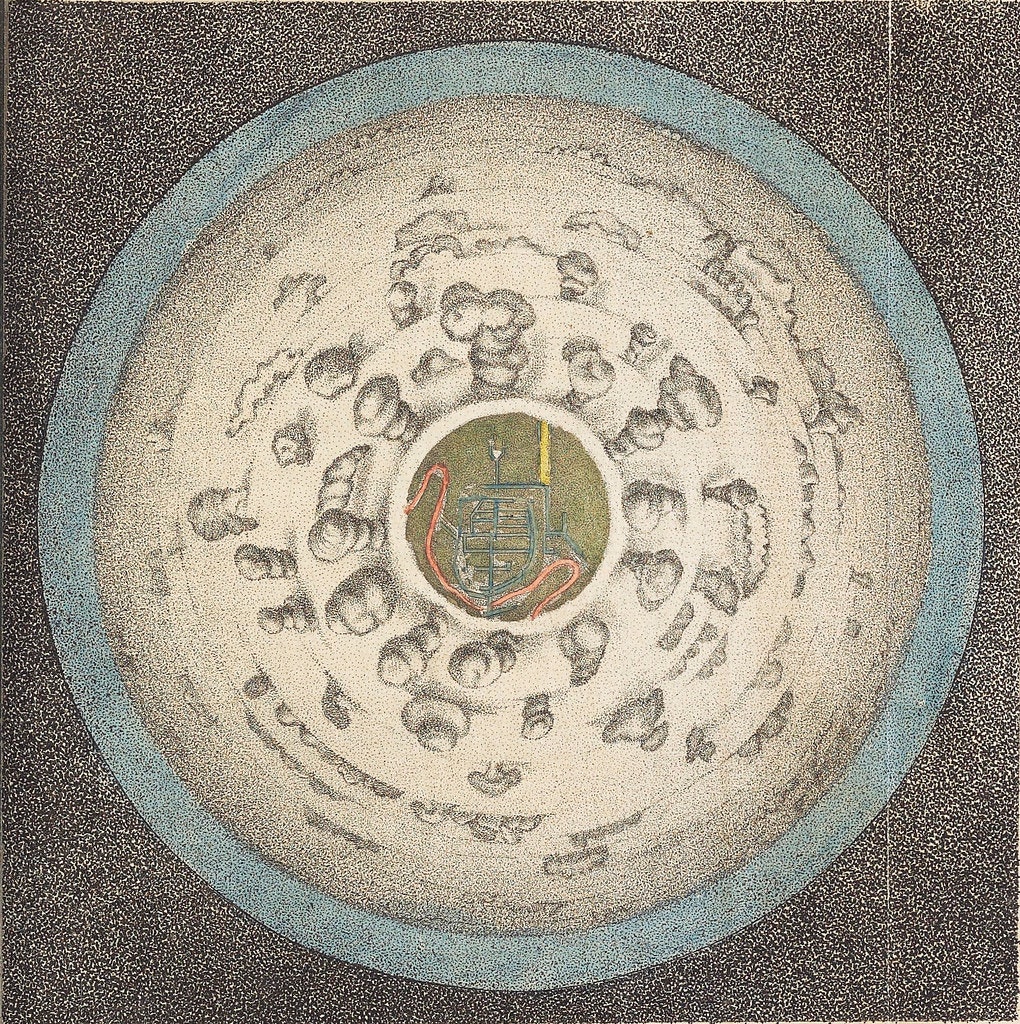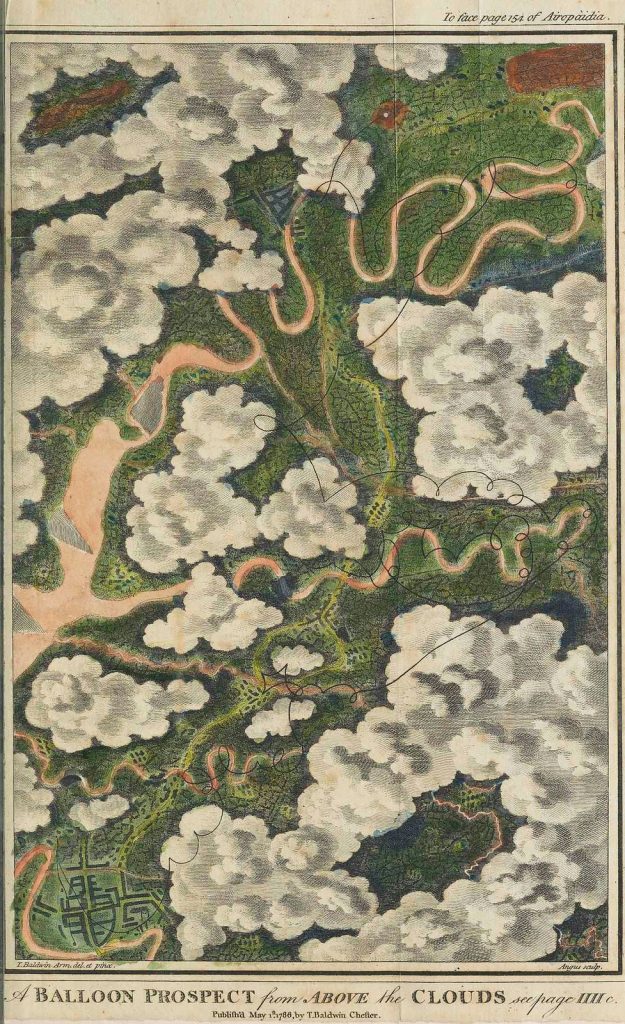The horizon line is a key visual principle of the Western world-view, binding together histories of navigation, spatial representation, and philosophical inquiry. Ancient mariners valued the horizon as an orienting boundary between the earthly and the celestial, scanning perpendicularly across an open field of vision to locate points of danger or solid ground. Renaissance architects projected that boundary onto the visual field of a canvas, drafting a straight horizon line to anchor an observer in pictorial space by coordinating converging planes around vanishing points, rendering a “here” and a “there”. Geniusas (2012) traces how modern European philosophers abstracted the horizon from the visual field and conceived of it as an orienting boundary between the perceptible and imperceptible, or immanent and transcendent. Then their fellows aimed for the clouds, and linear perspective began to drift.
In 1785 self-identified aeronaut Thomas Baldwin went on a balloon ride over England’s Cheshire county and published a book-length manuscript about his sole aerial excursion. Unlike most published accounts of mountain-top and balloon expeditions of the period, Baldwin’s (1786) Airopaidia was accompanied by two lavishly coloured etched plates with preface instructions. The most ambitious plate depicts a panoramic view from the balloon at its highest elevation point, see figure 1. Baldwin describes this image as a “suspended” perspective above the Center of View, “looking down on the Ampitheatre of white Floor of Clouds” (p.IIII). On the outer perimeter of the cloud opening, the spectator gets a second view “above the white Floor of Clouds, as he hangs in the Center, and looks horizontally round, into the azure Sky.” (p. IIII). The text’s capitalizations and italicsemphasize the cloud floor as a new, elevated horizon that orients vision both laterally and vertically.

Ford (2016) describes this etching as the first known rendering of an aerial view in flight. Visual maps that combined views from the ground and from above simultaneously, which Mark Rosen (2021) calls cartographic “double viewing,” preceded Baldwin’s flight by at least two hundred years. However, previous celestial perspectives – often denoted through peripheral clouds or vapor – represented an idealized divine perspective, and not a human sensory experience. Björn Billing (2019) identifies Baldwin’s image as a significant moment in the cultural history of the horizon, as the artist experimented with “visualizing sensory experience that transcended the pictorial models from the Renaissance, that is, geometric perspective and rectangular framing” (61). He adds that the circular horizon “abandons the idea of an abstract subject in Euclidean space in favour of a performative act” (69 – 70), aiming to simulate the experience of balloon flight. In accompanying instructions, Baldwin requested that the reader rest the plate on a flat lowered surface and examine it from above.
A key feature of the circular aerial view is its commitment to retaining the observer at the center of vision. The spherical rendering dispenses with the grounded eyeline of Renaissance pictorialism and embraces multipoint perspective, but it still organizes the landscape around an imagined viewer like a Copernican heliocentric map. The plate anticipates the enduring practice of arranging circular and panoramic images around an observer as the pivotal center, as detailed by Oetterman (1997).
In contrast, the second colour plate in Baldwin’s (1786) Airopaidia hints at a different experience. A Balloon Prospect from Above the Clouds is an expanded view of the Cheshire landscape partially obstructed by clouds, see figure 2. For best results, Baldwin instructs the reader to experience this scene through a rolled tube of paper – hovering above the image with one eye shut, and the other eye scanning the plate through the tube. His instructions bring to mind the technique of refielding in classic animation, when cinematic movement through space is choreographed by shifting or rotating the flat surface of a background underneath a camera, so as to reorient its horizon line in relationship to the frame.

Caren Kaplan (2017) notes that the choice to depict the earth as glimpsed through openings in the clouds endows this scene with a sense of immediacy and movement. Yet there is another remarkable feature in this image: the aerial view from above is overlaid with a looping serpentine line in black that traces the journey of the balloon horizontally across the landscape. As the line’s circuitous shape indicates, Baldwin’s journey into the clouds was not a steady vertical ascent into a static center, but a meandering and roundabout drift. Whereas the circular View from above promises a fully integrated, floating perspective anchored by the cloud floor, the Prospect’s erratic trajectory hints at continuous reorientation. How might one visualize the balloon’s actual ascent and descent – unmoored from land, and spun by atmospheric changes?
For a complement to Baldwin’s 1786 renderings of aerial vision, we might turn to the animated floating horizon in The Case of the Spiral Staircase (1981) by Dutch filmmaking duo Jacques Verbeek and Karin Wiertz, see figure 3.

Based on preparatory sketches and photographs of constructed models (documented by Peters, n.d.), the film begins with tight adherence to single-point linear perspective. The vertical pillar of a staircase is positioned as the anchoring line for winding steps and a descending figure. The composition begins to drift into an overhead view, and the vanishing point circles around the frame, creating the hypnotic effect of an orbiting upside-down camera. The pillar has suddenly disappeared. Without its receding lines to anchor the steps in place, they flutter in midair and begin to break formation. Disorientation is amplified by a travelling background of windows opening onto a skyscape. The entire corridor appears to spin among the clouds, and the figure’s confident descent becomes a cautious downward climb. Soon the steps take flight and soar out the windows like crisp paper airplanes, before the figure is also jettisoned out of frame.
Having meticulously established the rules of grounded linear perspective, The Case of the Spiral Staircase multiplies and dislocates its vanishing points into a dizzying, vertiginous flight. The film makes the case for animation’s capacity to un-ground and manipulate the pictorial horizon, sending the observer’s visual field into a tailspin. Neither the figure in this film, nor its spectator, are at the steady center of levitating vision. They are on the precipice of free-fall, spiraling out of control, challenged to reorient themselves by attending to collisions and divergences of the shifting planes around them.
References
Baldwin, Thomas. (1786). Airopaidia: Containing the Narrative of a Balloon Excursion from Chester, the Eighth of September, 1785. J. Fletcher, 1786.
Billing, Björn. (2019). Circular visions: viewing the world from above in the late eighteenth century.” Journal of Historical Geography, 63, 61-72.
Ford, Lily. (2016). “For the Sake of the Prospect: Experiencing the World from Above in the Late 18th Century.” The Public Domain Review.
Geniusas, Saulius. (2012). The Origins of the Horizon in Husserl’s Phenomenology. Springer.
Kaplan, Caren. (2017). Aerial Aftermaths: Wartime from Above. Duke University Press.
Oetterman, Stephan. (1997). The Panorama: History of a Mass Medium. Zone Books.
Peters, Mette. (n.d.). “Jacques Verbeek and Karin Wiertz: animated artwork.” Eye Filmmuseum website.
Rosen, Mark. (2021). Cartography and the other side of the clouds. Romance Quarterly, 68(3), 177-195.
Dr. Alla Gadassik is an Associate Professor of Media History and Theory at Emily Carr University of Art + Design (Vancouver, Canada), where she founded the Animate Materials Workshop. Her research and curatorial work explore animation’s rich material and production histories. Recent publications include an article on independent animation and gendered labour in Feminist Media Histories journal and an article on multiplane animation aesthetics in JCMS. Recent curatorial projects have focused on histories of graphite, ink, and textiles in animation.
